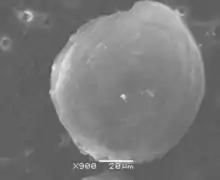Gambierdiscus toxicus
Gambierdiscus toxicus is a species of photosynthetic unicellular eukaryotes belongs to SAR supergroup, Alveolata, dinoflagellates which can cause ciguatera (also known as Ciguatera fish poisoning),[1] and is known to produce several polyether natural products, including ciguatoxin, maitotoxin, gambieric acid, and gambierol.[2][3] The species was discovered attached to the surface of brown macroalgae.[2]
| Gambierdiscus toxicus | |
|---|---|
 | |
| Scientific classification | |
| Domain: | |
| (unranked): | |
| (unranked): | |
| Phylum: | |
| Class: | |
| Order: | |
| Family: | Goniodomataceae |
| Genus: | |
| Species: | Gambierdiscus toxicus |
History
This species was first described by Adachi, R. & Fukuyo, Y in 1979 using samples collected around Gambier Islands.[4] Which was split into five different species (Gambierdiscus caribaeus, Gambierdiscus carolinianus, Gambierdiscus carpenteri, Gambierdiscus ruetzleri and Gambierdiscus toxicus) according to their morphological characteristic of thecal structure, and the sequence of both D1–D3 and D8–D10 regions in large-subunit rDNA.[5]
Distribution
This species can be found in tropical and subtropical regions in Pacific Ocean and Indian Ocean.[6] It is often found at the surface of various macroalgae, dead coral, sand and in water column[7] suggesting that the certain chemical compounds in algal exudates may plays an important role in the process of attachment .[7] In the present of light, the attached cell will detach from the substrate and start swimming in water column also, when a disturbance occurred, the swimming cells will again attach to the matrix.[8]
Secondary metabolites
This algae species is capable of producing a variance of bioactive polyketide natural products such as ciguatoxin with characteristic fused-ring cyclic polyether structure. It is believed that the biosynthesis pathway involved epoxide as an intermediates, which will undergo cyclization reaction to form the fused-ring cyclic polyether structure.[9]
Notes
- "Cook Islands Biodiversity : Gambierdiscus toxicus - Ciguatera Dinoflagellate". Cookislands.bishopmuseum.org. Retrieved 2012-06-08.
- Faust, MA and Gulledge (2002). "Identifying Harmful Marine Dynoflagellates". 42: 1–144. Cite journal requires
|journal=(help) - Cuypers, E.; Abdel-Mottaleb, Y.; Kopljar, I.; Raes, A. L.; Snyders, D. J.; Tytgat, J (2008). "Gambierol, a toxin produced by the dinoflagellate Gambierdiscus toxicus, is a potent blocker of voltage-gated potassium". Toxicon. 51 (6): 974–983. doi:10.1016/j.toxicon.2008.01.004. PMC 2597072. PMID 18313714.
- ADACHI, Rokuro; FUKUYO, Yasuwo (1979). "The Thecal Structure of a Marine Toxic Dinoflagellate Gambierdiscus toxicus gen. et sp. nov. Collected in a Ciguatera-endemic Area". Nippon Suisan Gakkaishi. 45 (1): 67–71. doi:10.2331/suisan.45.67. ISSN 1349-998X.
- Litaker, R. Wayne; Vandersea, Mark W.; Faust, Maria A.; Kibler, Steven R.; Chinain, Mireille; Holmes, Michael J.; Holland, William C.; Tester, Patricia A. (September 2009). "Taxonomy ofGambierdiscusincluding four new species,Gambierdiscus caribaeus, Gambierdiscus carolinianus, Gambierdiscus carpenteriandGambierdiscus ruetzleri(Gonyaulacales, Dinophyceae)". Phycologia. 48 (5): 344–390. doi:10.2216/07-15.1. ISSN 0031-8884. S2CID 86334317.
- Tester, Patricia A.; Litaker, R. Wayne; Berdalet, Elisa (January 2020). "Climate change and harmful benthic microalgae". Harmful Algae. 91: 101655. doi:10.1016/j.hal.2019.101655. ISSN 1568-9883. PMID 32057343.
- Parsons, Michael L.; Settlemier, Chelsie J.; Ballauer, Josh M. (April 2011). "An examination of the epiphytic nature of Gambierdiscus toxicus, a dinoflagellate involved in ciguatera fish poisoning". Harmful Algae. 10 (6): 598–605. doi:10.1016/j.hal.2011.04.011. ISSN 1568-9883. PMC 3182139. PMID 21966283.
- Nakahara, Hiroyuki; Sakami, Tomoko; Chinain, Mireille; Ishida, Yuzaburo (June 1996). "The role of macroalgae in epiphytism of the toxic dinoflagellate Gambierdiscus toxicus (Dinophyceae)". Phycological Research. 44 (2): 113–117. doi:10.1111/j.1440-1835.1996.tb00385.x. ISSN 1322-0829. S2CID 84070794.
- Van Wagoner, Ryan M.; Satake, Masayuki; Wright, Jeffrey L. C. (2014-06-16). "Polyketide biosynthesis in dinoflagellates: what makes it different?". Natural Product Reports. 31 (9): 1101–37. doi:10.1039/c4np00016a. ISSN 0265-0568. PMID 24930430.
